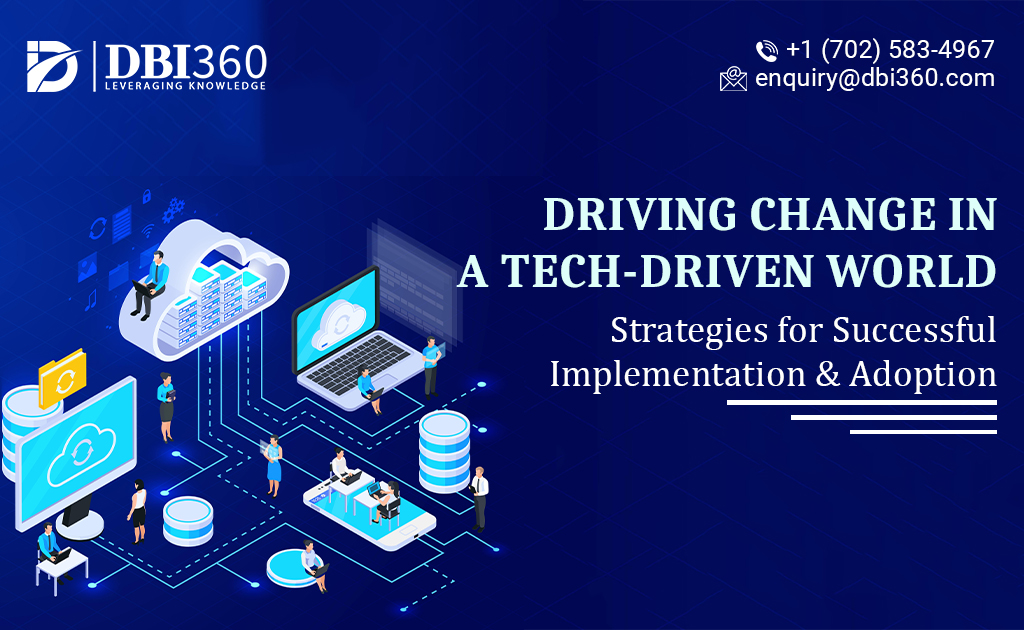In today’s fast-paced and technology-driven environment, organizations face the constant challenge of managing change effectively. The successful implementation and adoption of new technologies play a crucial role in gaining a competitive edge, improving operational efficiency, and driving business growth.
This blog will explore strategies for managing change in a tech-driven environment. From creating a change-ready culture to fostering stakeholder engagement and providing comprehensive training, we will explore proven approaches and best practices to ensure successful implementation and adoption.
Understanding the Need for Change: Setting the Stage for Success
To embark on a successful change journey, organizations must first recognize the need for change and set the stage for its successful implementation. This involves:
- Embracing technology trends:
- Acknowledge the impact of tech-driven environment trends on business operations and the need for continuous innovation and adaptation.
- Stay informed about emerging technologies and their potential benefits for your organization.
- Data-driven decision-making:
- Utilize data and insights to identify areas for improvement, prioritize change initiatives, and align them with strategic goals.
- Analyze market trends and customer preferences to identify technological advancements that can drive business growth.
- Building a change-ready culture:
- Foster a culture that embraces change, encourages innovation, and values continuous learning and improvement.
- Promote a growth mindset among employees and encourage them to embrace new technologies and ideas.
Effective Change Management Strategies: Planning for Success
Successful change management requires careful planning and the implementation of effective strategies. Here are some key strategies to ensure successful implementation and adoption:
- Clear vision and communication:
- Define a clear vision for the change, articulate its benefits, and communicate it effectively to all stakeholders.
- Ensure transparency and open communication channels to address questions and concerns throughout the change process.
- Stakeholder engagement:
- Engage key stakeholders from the beginning, involve them in decision-making, and address their concerns and expectations.
- Create a sense of ownership and shared responsibility by involving stakeholders in the planning and execution of change initiatives.
- Change champions and influencers:
- Identify organizational change champions who can drive the change, motivate others, and serve as role models.
- Leverage the influence of leaders and influencers to build support and momentum for the change.
Comprehensive Training and Support: Empowering Employees for Change
A critical aspect of successful change management is providing employees with the necessary training and support to embrace and adopt new technologies. Consider the following strategies:
- Tailored training programs:
- Develop comprehensive training programs that cater to different user groups and their specific needs.
- Provide hands-on training, workshops, and resources to ensure employees have the necessary skills and knowledge.
- Ongoing support and coaching:
- Offer continuous support through coaching, mentoring, and feedback mechanisms.
- Encourage a culture of continuous learning and improvement to help employees adapt to the change effectively.
- Addressing resistance:
- Anticipate resistance to change and proactively address concerns.
- Provide platforms for employees to express their doubts, offer solutions, and highlight the benefits and opportunities that change brings.
Monitoring and Evaluation: Assessing Change Effectiveness
To ensure the success of change initiatives, organizations must monitor and evaluate their progress. Consider the following strategies:
- Key performance indicators (KPIs):
- Define and track KPIs to measure the effectiveness of the change initiatives.
- Monitor metrics such as user adoption, productivity, customer satisfaction, and financial impact to assess the success of the change.
- Feedback and continuous improvement:
- Seek feedback from employees, customers, and other stakeholders to identify areas for improvement and make necessary adjustments.
- Foster a culture of continuous improvement by incorporating feedback into future change initiatives.
Conclusion
Managing change effectively in a technology-driven business landscape is vital for organizations seeking to stay ahead of the curve. By understanding the need for change, implementing effective change management strategies, providing comprehensive training and support, and monitoring the progress, businesses can successfully navigate change and leverage technology to drive growth and success. Embracing change as an opportunity for innovation and growth positions organizations for long-term success in an ever-evolving tech-driven environment.

